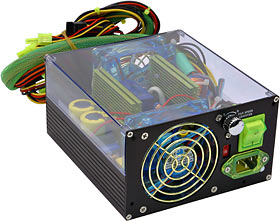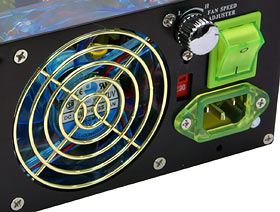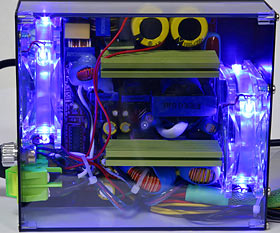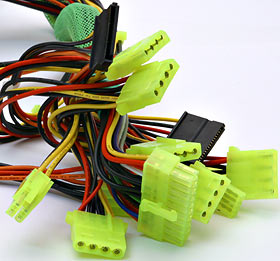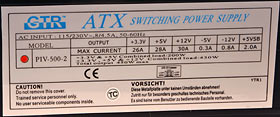
Quick Shot review 16:
GTR 450W-LI PSU
Review date: 9 January 2004.
Last modified
03-Dec-2011.
Another day, another PSU.
This isn't just any power supply, though.
In my last PSU review I talked about the kind of Power Supply Unit you're meant to buy if your case has windows and lights and mirror-balls and fluffy dice. Well...
...this is that PSU. Put wheels and a wing on it and it'd be ready to park at Bondi Beach on Saturday night.
This is GTR's 450W-LI. And, against all reason, it's actually not a bad PSU to choose even if you don't much care what your power supply looks like. That's because the 450W-LI's got decent specs to go with its 450 watt nominal rating, and here in Australia Aus PC Market are selling it for only $AU132 including delivery anywhere in the country. You can find a decent 450W PSU for a bit less than that, but not a lot less, so if you attach any positive value at all to the 450W-LI's outrageous looks, it's a good deal.
The 450W-LI's back panel is pretty normal, if you ignore the zombie-snot-green fittings (which, naturally, fluoresce under UV light...). The shiny chrome knob lets you turn down the power of the PSU's two fans, from the full one-point-something watts per fan (each fan has a 0.14 amp current rating) to close to nothing. At full speed this is a fairly quiet PSU (I've heard louder PSUs with only one fan); at minimum speed it's very quiet, but not as quiet as some. The two fans provide excellent throughflow ventilation; at full fan power this PSU is likely to provide adequate ventilation for a pretty beefy PC all by itself.
Posey enough for you?
Each of the fans is lit by four LEDs, which account for a significant slice of the fan power draw; without the LEDs, these fans wouldn't be good for much more than a watt each, which along with the smooth yellow-gold-plated finger guards (which produce less turbulence noise than the stamped-metal grilles) explains why the PSU is so quiet.
The LEDs and the fan motors all run from the same power supply, so turning down the fan power also turns down the light brightness.
If you like your case illumination on the subtle side, a 450W-LI is bright enough to be the sole source of light in a case. In the normal ATX tower case installation arrangement, the clear acrylic part of the 450-LI's casing will face down and it'll light up the computer passably well, as long as you've got the fans turned all the way up. If you want really bright lighting inside your case then you'll need to add a CCFL or big LED light or at least some accent lights, but if all you want is a mystic blue glow then the 450W-LI ought to do by itself.
PSUs, like PCs in general, rely almost completely on forced air cooling to get heat out of the case. The thermal conductivity of the casing matters very little, which is why the high thermal conductivity of aluminium PC cases isn't actually a selling point, and also why wooden and all-plastic cases work fine, thermally at least.
Nonetheless, the black half of the 450W-LI's casing is made from an aluminium extrusion, which should give it conductive cooling not much worse than a steel-cased PSU, despite its thermal-insulating acrylic half. This really ought not to matter if the fans haven't failed, though, and in that situation it won't help much. If all of the ventilation fans in a modern stacked PC fail, it'll get hot enough to hang in maybe an hour, and at that point you will, literally, be able to (slowly) cook eggs on top of it.
More alarmingly green UV-reactive plastic (it looks even weirder in real life, and the cable bundle is sheathed in green mesh, too), but these plugs are a bit better manufactured than the usual white nylon jobbies, and there's a decent number of them. As well as the normal ATX and ATX12V plugs, you get six "Molex" drive power plugs, two floppy power plugs, and two (black) SATA drive power connectors as well, which is a nice touch. There's no "AUX" plug for server motherboards, but few users are likely to miss it.
The possibly misleading, but nonetheless important, specs sticker. Note the information on combined load for the high current 3.3V and 5V rails, and for all three of the main power rails (3.3V, 5V and 12V) together. Add the 21.1 aggregate watts for the negative rails and the 5V standby rail to the 430 watt aggregate rating for the power rails, and you get a fair 450W overall figure.
Whether this PSU can really stay within spec when stretched all that way is questionable. The manufacturers claim it's passed a "100% Burn-In Test", but who knows how critically that was supervised. This is unlikely to be an issue, though. You've got to try pretty darn hard to make a PC that needs an actual 450 watts, unless it includes a bunch of Peltier heat pumps and cigarette lighters and 12 volt amplifiers. Most stacked systems will run fine from a decent 300W PSU, and even a drive-farm server box should be fine from the 450W-LI.
There's no harm in installing a monster PSU like this in an ordinary PC. The power rating is how much the power supply can deliver, not how much it draws all the time, so a given set of hardware running from a 300W PSU won't draw any more juice if you run it from a 600W PSU, all other things being equal.
If you're building a really mission-critical machine, of course, serious questions need to be asked if you decide to use a light-up show pony of a PSU like this one. A couple of rather more expensive redundant PSUs are likely to be the order of the day, in that case. But this PSU would be adequate, in a pinch.
Overall
GTR have gone so far as to actually put a badge on the 450W-LI, but who knows who really makes the thing. I wouldn't be surprised to discover that it's yet another fine product of the factory in Guangzhao, China from which various big competing PSU brands all source their hardware.
Aus PC Market have been selling GTR gear long enough to be confident that it's not more frequently implicated in horror stories involving the strong smell of exploded electrolytic capacitors than various other brands, though, so this is another PSU that I wouldn't mind using in my own computer.
If you consider a clear case and glowy fans to be a minus rather than a plus, you probably haven't even read this far. You can get a PSU with the same practical capabilities as this one for less than the $AU132 delivered that the 450W-LI costs.
If you'd like a pretty cheap and extremely cheerful show-off PSU with a hefty rating, though, the 450W-LI should suit you down to the ground. Recommended.
Buy one!
Readers from Australia or New Zealand can purchase the GTR-350ATX from Aus
PC Market.
Click here!
